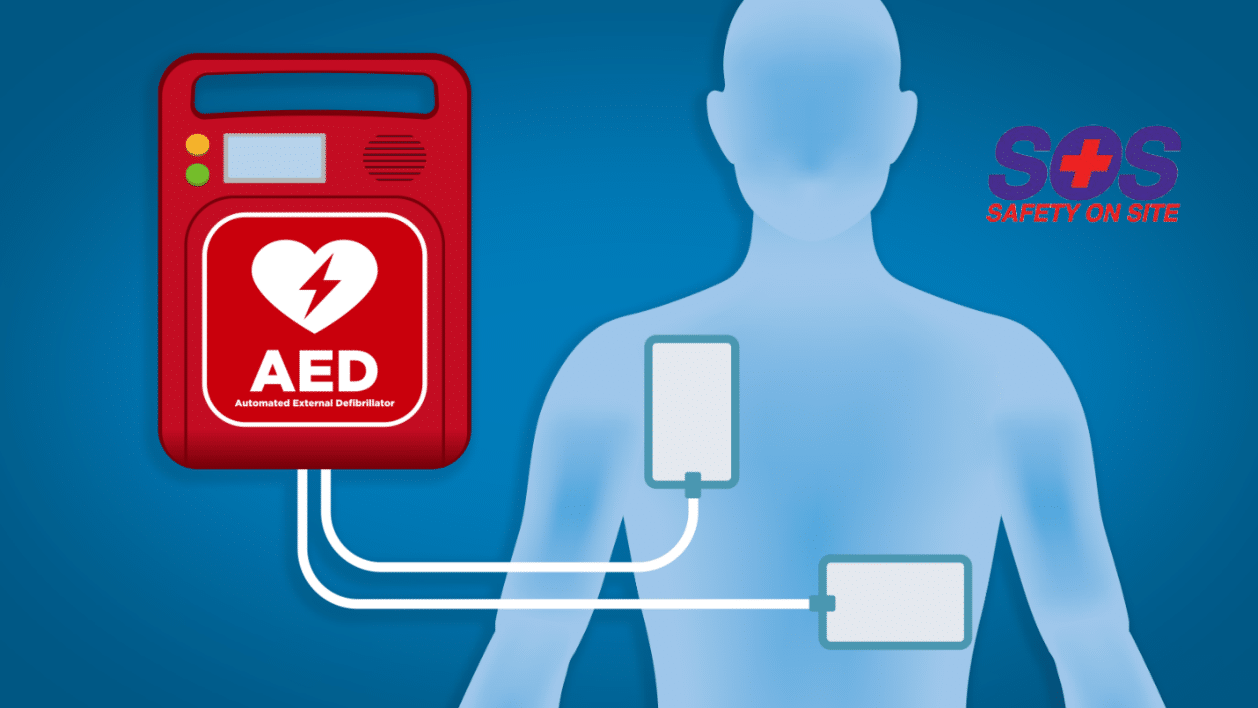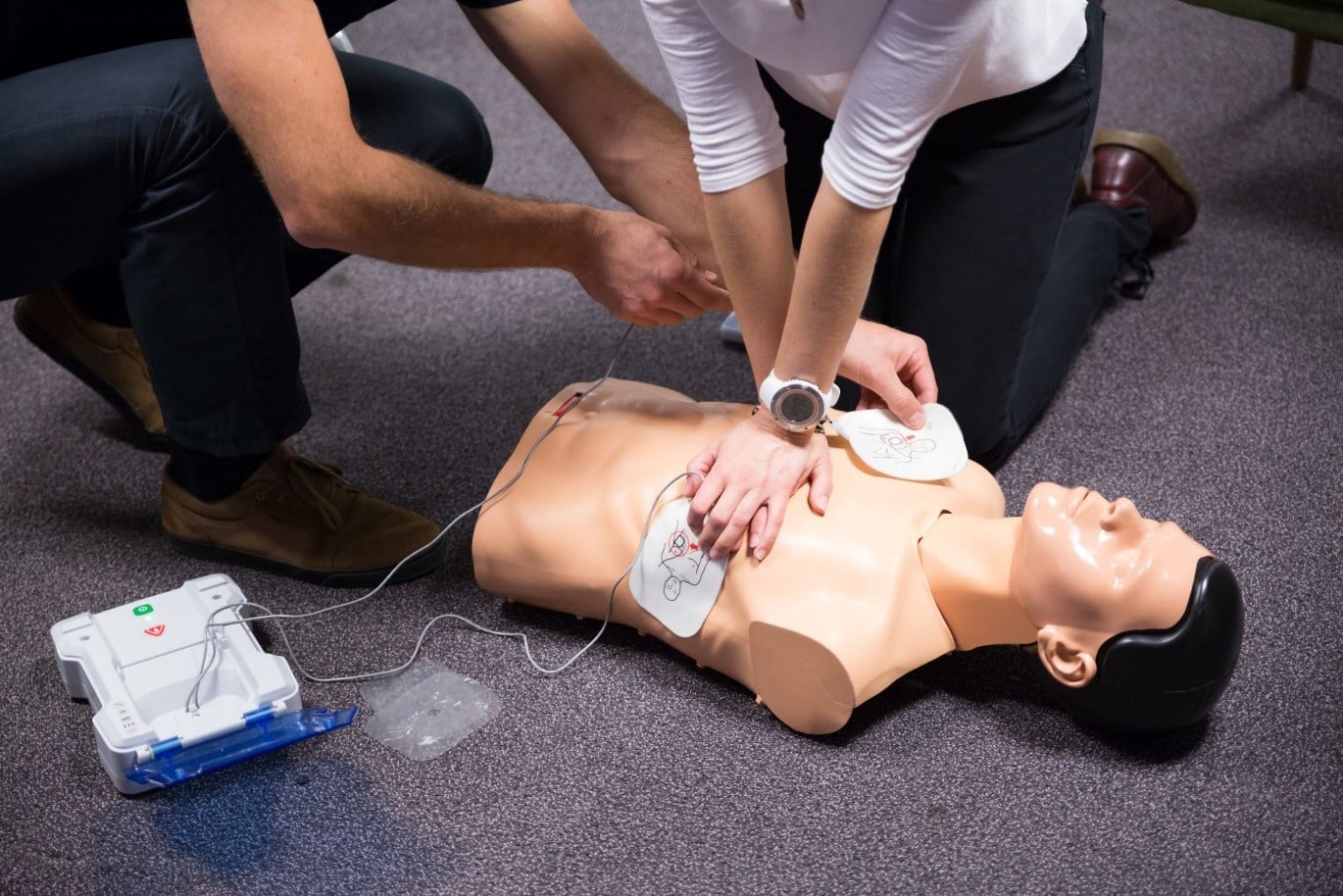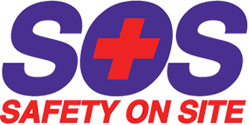
Do you need to be trained to use an AED?
Yes, it is important to be trained on how to properly operate an automated external defibrillator (AED). While an AED is designed to be easy to use, a CPR and AED certification course will help learners build confidence and skills that can lead to the best outcomes in a medical emergency. Various organizations provide AED training, including Red Cross Training Partner, SOS First Aid and Safety Training, in the Greater Hamilton and Toronto areas. It’s always wise to obtain proper training before using an AED.

When should you use an AED?
An AED should be used right away when a person is in cardiac arrest. This is when the heart suddenly stops beating, the person becomes unresponsive and isn’t breathing normally. A cardiac arrest can be caused by many things including a breathing emergency, a heart attack, electric shock, and drowning to name a few. In these situations, the AED, when used properly, delivers an electric shock to the heart, which helps to restore its normal rhythm. If the AED is used immediately before the arrival of medical professionals, it can significantly increase the likelihood survival for a person whose heart has stopped. It is vital to remember to call 911 or emergency medical services (EMS) as soon as a person goes unconscious and before using an AED.
How do you use an AED?
Use an AED when a person is unresponsive and not breathing normally, you will need to assess first the person’s level of responsiveness and ABCs (Airway, Breathing, Circulation). If the person does not respond and isn’t breathing normally, immediately call emergency medical services (EMS) and begin CPR while another bystander retrieves the AED. If there is no bystander to help you, you will need to retrieve the AED yourself. Once the AED arrives, turn it on and follow the voice instructions. Attach the electrode pads to the person’s bare chest, and the AED will analyze the heart rhythm. If the AED detects a shockable rhythm, it will instruct you to stand clear and to administer a shock by pressing the shock button. Do not touch the patient when the device is analyzing or administering a shock. Remember to always follow the device’s prompts and continue to perform CPR until the device advises you to stop or until EMS arrives.
When should you not use an AED?
In some situations, an AED should not be used. Do not use an AED on someone who is responsive, breathing or has a pulse. Also, do not use an AED on someone who is wet or in contact with water. Water can conduct electricity and cause an electric shock to the first aider or the person in medical distress. If a person is wearing a pacemaker or internal defibrillator, make sure to place the electrode pads at least an inch away. Finally, if the chest is covered with a medication patch, like a nitroglycerin patch or a nicotine patch, it should be removed before using an AED. Gloves should be worn to remove medical patches. In any case, it’s essential to receive training, follow the instructions of the AED and call 911/EMS before using the device.

Where can you find AEDs in Ontario?
AEDs can be found in many public areas in Ontario, like public transportation hubs, airports, sports complexes, shopping malls, theatres, and community centers. Moreover, many workplaces, schools, and healthcare facilities have at least one AED on site. In Ontario, you can use the “AED Locator” tool provided by the Heart and Stroke Foundation of Canada website, which allows you to search for AEDs by location, address, or postal code. You can also contact your local EMS or healthcare provider for information on where to find AEDs in your area.
Can you use an AED on a pregnant woman?
Yes, an AED can be used on a pregnant woman who is in cardiac arrest. The device will not harm the fetus.
Should you buy an AED for your home or business?
The cost of AEDs has come down substantially over the years and there are good Samaritan laws that protect people who use them appropriately. You can easily purchase an AED at places like COSTCO and Staples nowadays. However, there are some considerations to keep in mind. In addition to the cost of the device, you should take in account the costs to maintain the device and to train staff. The AED should be appropriate for the intended location, and it should be placed in an easily accessible location in the event of an emergency.
Is there anything else you should know about AEDs?
Yes, it’s important to know that using an AED is just one lifesaving component for someone in cardiac arrest. Cardiopulmonary resuscitation (CPR) and calling emergency medical services (EMS) are also critical steps in saving a person’s life. When using an AED, it’s vital to follow the device’s voice prompts and make sure that no one is touching the person who is being treated. It’s also important to remember that AEDs are designed to treat an abnormal heart rhythm, and they may not be effective in cases of respiratory arrest or other emergencies. In all situations, calling for emergency medical services (EMS) immediately is a crucial step to provide the best chance of survival.






